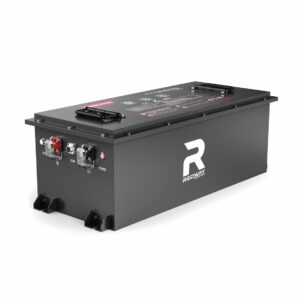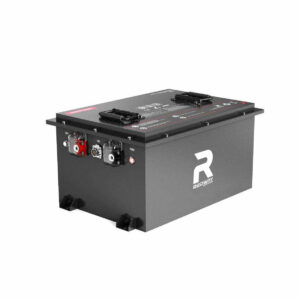What Factors Determine RV Battery Lifespan and Performance?
RV battery lifespan and performance depend on battery type (AGM, lithium, lead-acid), charging habits, depth of discharge, temperature exposure, maintenance frequency, and usage patterns. Lithium batteries last 5–10 years with proper care, while lead-acid lasts 3–5 years. Regular maintenance, avoiding over-discharge, and temperature control optimize performance.
How Do Battery Types Influence RV Battery Longevity?
AGM, lithium, and flooded lead-acid batteries have distinct lifespans. Lithium batteries tolerate deeper discharges (up to 90%) and last 2–3x longer than lead-acid. AGM batteries offer spill-proof durability but degrade faster if discharged below 50%. Lead-acid requires water replenishment and suffers from sulfation if undercharged. Matching battery type to RV power demands ensures cost-effective longevity.

Lithium iron phosphate (LiFePO4) batteries dominate modern RVs due to their 80% depth of discharge capability and 3,000+ cycle life. Unlike AGM batteries, which lose capacity after 500 cycles at 50% discharge, lithium maintains 80% capacity after 2,000 cycles. For seasonal campers, sealed lead-acid remains economical despite shorter lifespans. Cold weather impacts AGM and lithium differently—AGM loses 30% capacity at 32°F, while lithium requires internal heating below -4°F to prevent damage. Hybrid systems combining starter batteries (for engines) and deep-cycle lithium (for appliances) optimize both longevity and cold-cranking performance.
| Battery Type | Cycle Life | Optimal Discharge | Temperature Range |
|---|---|---|---|
| LiFePO4 | 3,000–5,000 | 80–90% | -4°F to 140°F |
| AGM | 500–1,200 | 40–50% | 32°F to 104°F |
| Flooded Lead-Acid | 300–700 | 30–50% | 50°F to 86°F |

What Maintenance Routines Optimize RV Battery Performance?
Clean terminals monthly with baking soda to prevent corrosion. Check lead-acid water levels every 2–3 months—use distilled water to refill. Equalize lead-acid batteries every 3–6 months at 15.5V for 2–4 hours. Test specific gravity with a hydrometer. For lithium, firmware updates and cell balancing extend BMS accuracy. Annual load testing identifies weak cells early.
Corrosion prevention is critical for lead-acid terminals—apply dielectric grease after cleaning. Lithium batteries require minimal maintenance but benefit from quarterly cell voltage checks using a multimeter. Load testing involves discharging batteries to 50% capacity and measuring voltage recovery speed. Slow recovery indicates sulfation in lead-acid or BMS issues in lithium. Storage protocols differ: lithium should be kept at 30–50% charge, while lead-acid needs a full charge before storage to prevent sulfation. Use thermal blankets in freezing climates to reduce lithium self-discharge rates by 40%.
“RV owners often overlook battery temperature. Lithium batteries can lose 30% capacity at -4°F, but a $200 heated battery pad solves this. Always use a battery management system (BMS) with cell-level monitoring—it’s the difference between a 10-year lifespan and a $2,000 replacement.” — Redway Power Solutions Engineer
EV/RV Battery Production Line introduced, How Was EV/RV Battery Before Shipment
News
Factors Determining RV Battery Lifespan and Performance:
- Material Quality and Design: High-purity copper conductors and multi-stranded flexible designs enhance conductivity and durability
- Thermal Management: Advanced cooling systems (e.g., liquid cooling) prevent overheating and degradation
- Usage Patterns: Deep discharge cycles, temperature exposure, and charging habits impact longevity
- Battery Chemistry: Innovations like silicon-carbon anodes and solid-state electrolytes improve energy density and cycle life
2025 Latest Developments in RV Battery Field:
1. Solid-State Battery Commercialization
South Korea’s LG and Samsung showcase 46-series solid-state batteries for EVs and RVs, achieving 1,000+ km ranges with 350Wh/kg energy density .
2. Sodium-Ion Battery Breakthroughs
China’s Tian battery develops electrolyte formulations boosting sodium-ion cycle life to 5,000+ cycles, with -40°C performance for cold-weather RV use .
3. AI-Driven Battery Management Systems
New BMS platforms integrate digital twins and real-time analytics to optimize charging, prevent over-discharge, and extend RV battery lifespan by 20-30%.
FAQs
- How Often Should I Replace My RV Battery?
- Lead-acid: 3–5 years; lithium: 8–10 years. Replace if capacity drops below 70% or physical damage (swelling, leaks) occurs.
- Can I Mix Old and New RV Batteries?
- No—mismatched batteries cause uneven charging, reducing overall lifespan. Replace all batteries in a bank simultaneously.
- Is a Lithium RV Battery Worth the Cost?
- Yes, for frequent boondocking. Lithium offers 2x more usable energy, faster charging, and 3x longer cycle life than lead-acid.
Know more:
What Are the Different Types of RV Batteries and Their Key Differences?
Which Battery is Better for Your RV: Lithium-Ion or Lead-Acid?
What Factors Determine RV Battery Lifespan and Performance?
How Do Solar Panels Integrate with RV Battery Systems?
What Are the Essential Safety Precautions for RV Batteries?
How Do Temperature Extremes Impact RV Battery Efficiency?
